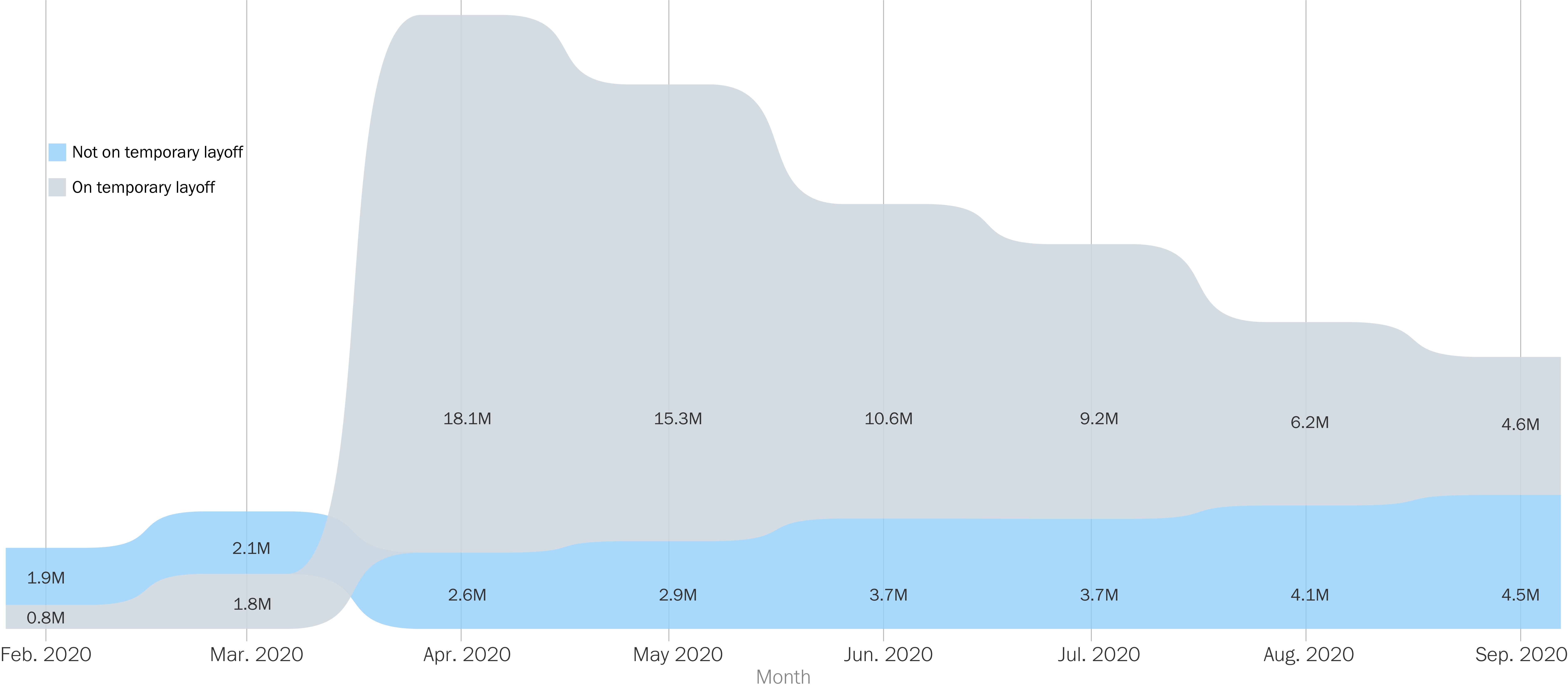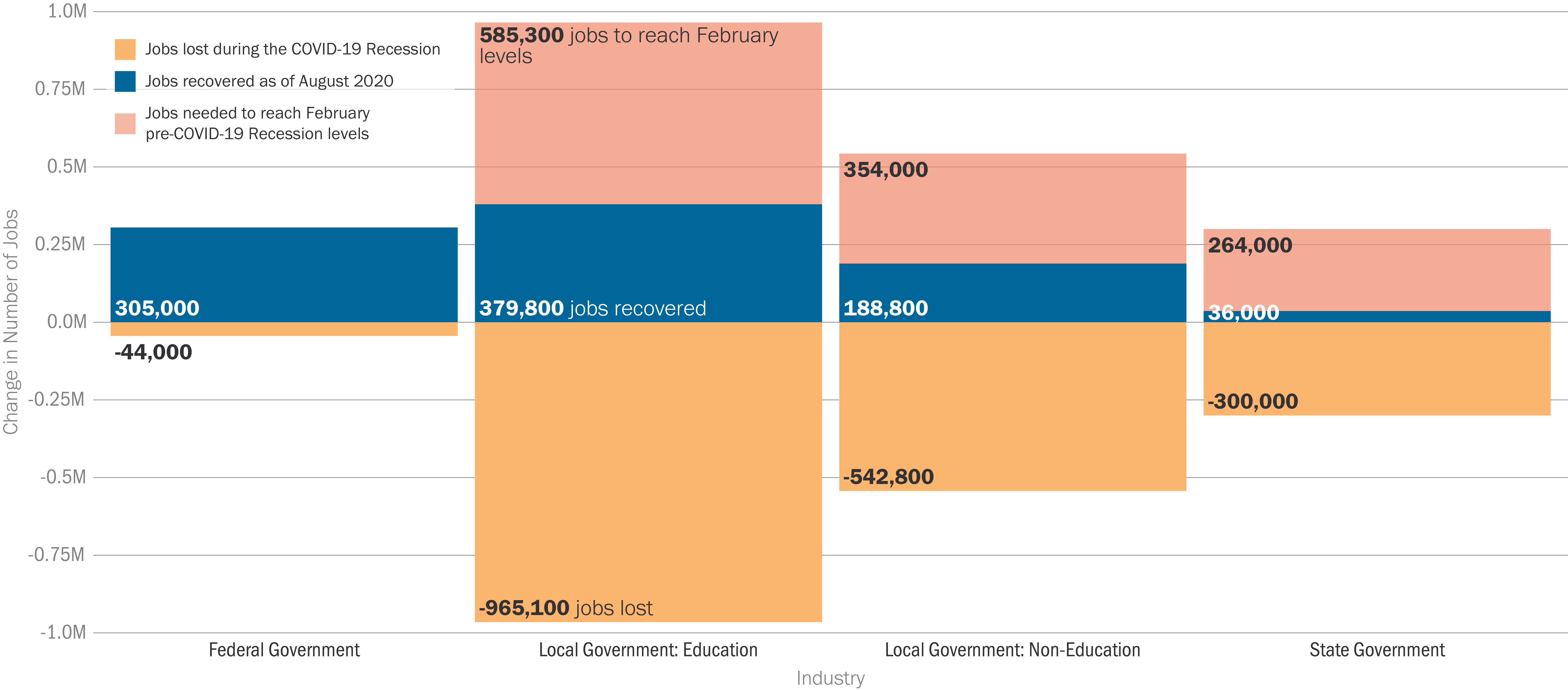Local Governments Lose Jobs as Slowdown in Recovery Begins: Local Government Employment Decreased in September, Driven by Education Related Job Loss
Author
Kevin Shrawder

Stacy Nakintu

Ricardo Aguilar
Upcoming Events
Related News
|
Reversing course from slight increases in local government employment in August, the September jobs report from the U.S. Bureau of Labor Statistics (BLS) showed a decrease of 134,000 local government jobs. This includes education-related jobs which reportedly declined by 231,100 jobs in September, offset slightly by marginal increases of 96,400 in non-education jobs.
The unemployment rate fell to 7.9 percent in September, a 0.5 percentage point decrease from the previous month, indicating a slowdown in economic recovery. Despite positive trends on many indicators in recent months, all signs point towards a shaky ending to 2020 unemployment levels with many sources predicting a return to normal economic levels not occurring until at least 2022 or mid-2023.1 2
Unemployment Rate Decreases Marginally in September, Remains Well Above February Levels
U.S. unemployment rate, 2007-2020

Despite a decrease in the unemployment rate to 7.9 percent in September, unemployment levels remain 4.4 percentage points higher than February levels. This .5 percentage point change from August levels is the lowest increase the economy has experienced thus far during the pandemic, likely exhibiting the beginnings of a slowdown in recovery efforts. During the great recession, the unemployment rate took 89 months to return to pre-recession lows as the effects of the recession lingered. Despite many differences between the two recessions, the great recession points to a long and unsteady recovery process with the circumstances of the pandemic further compounding the uncertainty of this crisis.
Nationally, 661,000 jobs were added to the economy in September though 12.6 million Americans remain unemployed. This increase makes September the sixth consecutive month of increased employment. The number of workers who were permanently laid off also increased for the sixth month this year by 345,000 and has risen by a total of 2.5 million jobs since February, demonstrating that workers returning from temporary layoffs have been driving the increases in employment since April.
Local Government Employment Decreases in September, Driven by Education Related Job Loss
Change in employment by government type, Feb.- Sep. 2020
Though all levels of government reported job loss this month, the local government experienced the largest decrease in employment. Education-related jobs in local government decreased by 231,100 in September, now 585,300 jobs below the February level. Non-education local government jobs increased by 96,400, remaining 354,000 jobs below its February level. Up until this point, state government and federal government jobs have been recovering more quickly than local government jobs. However, state employment lost a total of 48,000 jobs, now 264,000 jobs below February levels and federal government employment lost a total of 34,000 jobs. Though the federal government lost jobs, employment remains 261,000 jobs higher than February levels likely explained by the ongoing efforts for the 2020 Census. With the future of schooling continuing to be uncertain, education-related job loss is troubling as significant impacts on this sector could be long-lasting. Local government employment remains 939,000 jobs short of the February level, on track with economic forecasts indicating continued job losses including up to an additional 1 million fewer jobs for state local government through late 2021, with workers having the ability to return to jobs sometime in 2022. 3
LOCAL GOVERNMENT EMPLOYMENT REMAINS 939,000 JOBS SHORT OF FEBRUARY LEVEL
Change in employment by selected industries, Feb.- Sep. 2020

In contrast to the local government sector, the August jobs report suggests other major industries continued to recover, despite substantial gaps that exist between February and September levels.
- Leisure and hospitality added 318,000 jobs in September yet remained 3.84 million jobs lower than February. Almost two-thirds of the gains occurred in food services and drinking places (+200,000 jobs).
- Retail trade added 142,400 jobs over the month, with gains widespread within the industry. Employment in retail trade is down by 483,000 since February.
- Health care and social assistance rose by 108,000 in September but is down by 1 million since February.
- Professional and business services added 89,000 jobs in September. Despite gains of 910,000 since April, employment in professional and business services is down by 1.4 million since February.
- Employment in transportation and warehousing rose by 74,000 in September. Although the industry has added 291,000 jobs since May, employment in transportation and warehousing is down by 304,000 since February.
- Manufacturing added a nominal 66,000 jobs over the month. Despite gains in the past 5 months, employment in manufacturing is 647,000 jobs below February levels.
- Education and health services added 40,000 jobs in September yet remained 1.4 million jobs lower than February.
- Construction added only 26,000 jobs in September but is similarly 394,000 jobs lower than in February.
- All other major industries added at least a few jobs, including mining and logging, which notably broke a decreasing streak by gaining 1,000 jobs in September - now only 101,000 jobs lower than February
Increases in Permanent Job Losses Continue as Economic Recovery Slows
Total number of unemployed workers on temporary layoff vs. not on temporary layoff, Feb. - Sep. 2020

Even though there has been a steady increase in employment each month since April, the nation is far from recovering. The BLS reported that the number of workers on temporary layoff decreased by 1.5 million – driving the jobs growth seen in September. On the other hand, the number of workers who permanently lost their jobs increased by 345,000 to 3.8 million – totaling 2.5 million people higher than in February. Though indicators appear to be normalizing with non-temporary layoffs significantly declining, the steady increase of permanent job losers furthers the concern of a plateau in recovery efforts that may likely be long-lasting.
In April, unemployment was driven by temporary layoffs, which made up 88 percent of the 20.6 million job losses (by contrast, temporary layoffs comprised only 29 percent of all job losses in February). Since April, the overall number of laid-off workers has been steadily decreasing, as has the number of workers on temporary layoff. Permanent job losers, however, have been increasing each month since February (except for July). In September the share of permanent job losers (9.1 million) comprised 41 percent of laid-off workers—an increase of 2.5 million since February. Thus, the 11.5 million workers seen returning to work since April are primarily workers ending their periods of temporary layoff. The ever-increasing 2.5 million workers who have been permanently laid off since February underscores a more accurate picture of COVID-19’s longer-term economic toll and true job loss. Long term unemployment increased by 781,000 jobs between August and September, now 1.3 million above February.
The Coronavirus pandemic is preventing workers from finding jobs
The BLS recently added supplemental information on the pandemic’s direct impact on the labor force. In September, approximately one quarter (22.7 percent) of workers teleworked at some point due to COVID-19. Over 19 million workers in September reported that their employer closed or lost business during the pandemic, not allowing them to work their full number of hours. Finally, 4.5 million people were prevented from looking for work due to the pandemic, meaning they were not counted as unemployed or part of the labor force (since a person must be actively looking for work to be counted as unemployed).
Overall, the September jobs report reveals a national economy that displays indicators of a slowing recovery. Months ago, the federal government invested trillions of dollars to prop up the economy and now the economy may be losing steam in the uphill climb out of the recession. Without additional funding, essential local government services and workforces may face additional cuts, further weakening the U.S. economy and the nation’s ability to recover.
Endnotes
- John Lonski, Moody's Research “Markets, Bankers and Analysts Differ on 2021’s Default Rate” (2020), available at https://m.moodys.com/wmo
- David Payne, Kiplinger“Recovery Has Begun, but Progress May Slow” (2020), available at https://www.kiplinger.com/
- Daniel Bachman, Deloitte“United States Economic Forecast: 3rd Quarter 2020” (2020), available at https://www2.deloitte.com
